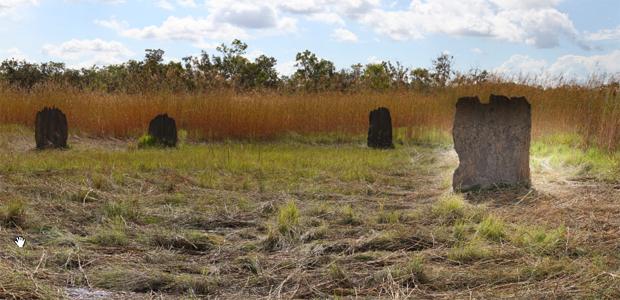Australia’s ‘magnetic’ termites interesting to study, tough to understand
These mounds are home to “magnetic” termites in Australia’s Litchfield National Park. (Photo by Ari Daniel Shapiro.)
Editor’s Note: This story is a co-production of PRI’s The World and NOVA.
If you drive from Darwin in Australia’s Northern Territory and head south, things get rural pretty quickly.
And soon, if you look off the side of the road, you will see unusual structures through the trees.
They look like giant, gray planks of dirt. They stand on edge, as if surging out of the ground.
When Graham Brown spotted one such monolith just off the Stuart Highway, he could not resist hopping out of his truck.
“It looks like a tombstone,” Brown said. “But a very, very large tombstone for a grave.”
Brown is the former curator of insects at the Northern Territory Museum, and he explains that this is actually a peculiar type of termite mound.
“The orientation of the nest is basically north-south,” he said. It points like a compass needle. “Hence the common name (of these insects) — magnetic termite.”
It has long been a mystery just how and why these insects align their homes with the poles of the Earth, but there are clues, Brown says.
Sense of Direction
Despite their name, the termites themselves are not magnetic — they wouldn’t stick to your refrigerator! But, Brown says, “there is some suggestion that the termites can be affected by magnetic fields.”
In one experiment, scientists buried magnets in the ground on either side of where termites were starting to build new mounds. When the researchers came back years later, the termites had abandoned these mounds, perhaps because their sense of direction had been thrown off. So it seems that the termites can sense the Earth’s magnetic field, and that may be how they orient their homes.
As for why they build their homes this way, Brown explains that these towering mounds are essentially termite apartment buildings.
A single nest may contain tens of thousands of termites. To comfortably house all those insects, the mound needs to have just the right architecture. He says all the little rooms, or galleries, need the proper moisture level and a good internal temperature, and the north-south alignment of the mounds seems to help keep the termites comfortable.
“This being Northern Australia, the sun is hot in the morning and even hotter in the afternoon,” Brown said.
Around noon, the sun is strongest. But since these mounds are long and skinny and pointed north-south, just the edge of the mound faces the sun at that hour. That gives the mound “a narrow profile to the sun at that particular time of day,” Brown says, and keeps the termites from getting overheated.
At least that is one theory.
But another puzzle remains: if this is such a good way to build a mound, why don’t more termite species do it?
Brown doesn’t know the answer. But he is pleased to live in the only place in the world where you see the unusual homes of these skilled insect engineers.
Every day, reporters and producers at The World are hard at work bringing you human-centered news from across the globe. But we can’t do it without you. We need your support to ensure we can continue this work for another year.
Make a gift today, and you’ll help us unlock a matching gift of $67,000!
